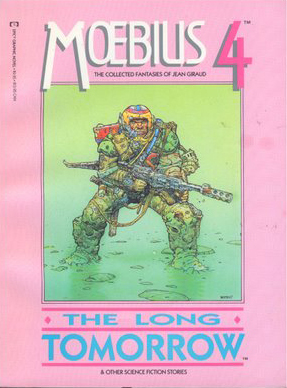 By JEAN “MOEBIUS” GIRAUD (Marvel; 1987)
By JEAN “MOEBIUS” GIRAUD (Marvel; 1987)
You simply can’t go wrong with Jean “Moebius” Giraud (1938-2012). One of France’s premiere cartoonists and designers, his graphic narratives remain among the finest examples of the form. That’s true even of the contents of THE LONG TOMORROW & OTHER SCIENCE FICTION STORIES, one of several trade paperback collections of Moebius works (the third, to be exact) published by Marvel in the late eighties. Overall this book ranks far from the top in the Moebius hierarchy, yet contains one absolutely indispensable portion.
That would be the 1975/76 title story, scripted by the late Dan O’Bannon. Moebius and O’Bannon were part of Alejandro Jodorowsky’s legendary unmade DUNE adaptation, and “The Long Tomorrow” was one of a handful of Moebius illustrated narratives to emerge from the wreckage of that project (others include THE EYES OF THE CAT and the INCAL saga). According to an afterward by Moebius, “The Long Tomorrow” began as an illustrated story made by O’Bannon while working on Jodorowsky’s film; the tale was intended as a science fiction-tinged parody of 1940s detective fiction, but, as Moebius quickly discovered, it emerged as “something even more original than the original source material.”
Moebius was moved to create his own version of “The Long Tomorrow,” and it showcases him at his finest. The intricately detailed futuristic décor, which comes complete with corporate logos and a wholly unique fashion sense, is astonishing, as is an otherworldly creature that turns up in the final panels. Those things were furthered in the O’Bannon scripted ALIEN, upon which Moebius worked as a conceptual artist, and also BLADE RUNNER, which Moebius didn’t work on but which partook quite heavily of the artwork displayed here. As for the narrative of “The Long Tomorrow,” it involves a tough private eye in some future society who after being contracted by a ritzy “dame” to track down an errant lockbox is drawn into a conspiracy.
The other stories, most of them emerging from the pages of France’s Metal Hurlant magazine, aren’t as strong. Interplanetary science fiction is the major theme, and, as Moebius makes clear in his textual afterwards, his chief inspirations were the pulp science fiction tales of old (with Robert Sheckley being the most frequently invoked author). Included are “There is A Prince Charming on Phenixon,” in which a man and woman cosmonaut land on an alien planet and get involved with a strange, but quite soulful, tentacle-creature; “Variation No. 4070 on “The” Theme,” containing Moebius’ bleak-yet-darkly comedic take on nuclear war; and “Approaching Centauri,” another elaborate sci fi fable, this one scripted by Moebius’ fellow French comics genius Philippe Druillet.
“Approaching Centauri” contains a futuristic milieu that’s nearly as detailed as that of “The Long Tomorrow.” It features several astronauts on a spaceship making the jump to hyperspace, only to have one of them get projected out of the continuum, and into a psychedelic hell in which he’s ripped apart by demons. Affecting, but I’d really like to have seen what Druillet himself might have done with the tale, as the potbellied devil critters shown menacing the protagonist are, as Moebius admits in his afterward, not all they could be.


